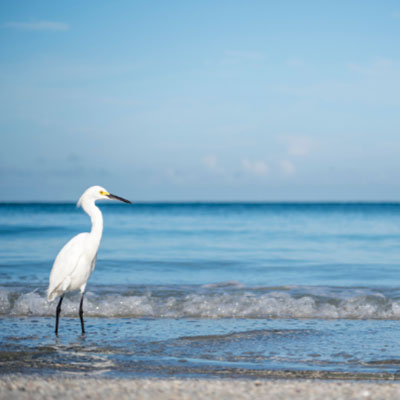Moving to Florida: Discover the Sunshine State
We created this guide for moving to Florida to help those who are in their very early stages of researching where they’d like to move. So, what exactly do you need to know before moving to Florida? We’ve compiled some of the most important items you should consider when making this big decision. According to 2020 Census data, Florida was one of the top ten fastest growing states of the last decade in terms of population, with a massive 14.6% growth in population. So, is moving to Florida right for you?
What You Need to Know about Florida’s Geography

Florida is in the southeastern U.S. with the Gulf of Mexico to the west, Alabama to the northwest, Georgia to the north, the Bahamas and the Atlantic Ocean to the east, and the Straits of Florida and Cuba to the south. Fun fact: Florida is the only state that borders both the Gulf of Mexico and the Atlantic Ocean! If you love exploring the outdoors, Florida may be the right place for you. In fact, with an area of 65,758 square miles, Florida spans two time zones and has several distinct ecosystems within its borders. In fact, Florida is one of the largest states east of the Mississippi River!
The Everglades National Park in the southern part of the state is the largest tropical wilderness in the U.S. and among the largest in the Americas. Near the Florida Keys at the far southern part of the state is the Florida Reef, the only living coral barrier reef system in the continental United States and the third-largest coral barrier reef system in the world.
From the Apalachicola National Forest with a massive 633,000 acres of woodlands near the state capital to Biscayne National Park in between the Everglades and Miami and Dry Tortugas National Park and Big Cypress National Preserve in between, Florida has a lot of incredible nature to behold. (There are also lots of interesting museums around the state, including the Orlando Science Center, St. Augustine Pirate & Treasure Museum, and the Kennedy Space Center, to name a few!)
Florida’s highest point, Britton Hill, stands at 345 ft tall making it the lowest high point of any U.S. state. By comparison, Florida’s lowest point found in the Atlantic Ocean, and it’s 0 ft above sea level! Although Florida is mostly flat, places such as Clearwater have promontories that rise 50 to 100 ft above the water, make for some interesting geography.
Moving to Florida Guide on the Weather in Florida

Florida’s climate is tempered somewhat because no part of the state is too far from the ocean. It may surprise you to learn that due to its subtropical and tropical climate, Florida rarely receives any measurable snowfall! This means that summers can feel like winters and winters can feel like summers! Summer temperatures rarely exceed one hundred degrees and low temperatures drop into the sixties. Winter temperatures usually stay around seventy and into the low eighties before dropping down into the low forties. Florida may be the “Sunshine State,” but severe weather is a common occurrence in the state.
There are dangers associated with tornados, but they do not typically reach the same intensity as those in the Midwest. Hurricanes and flooding are the real dangers in Florida, with hurricane season lasting from June through November, which should be something to consider if you plan to build a home after moving to Florida.
Moving to Florida Guide on Getting a Job in the Sunshine State

If you’re looking for a place to grow your career, consider moving to Florida! According to a recent Florida Department of Economic Opportunity press release, at the time of authoring this article, the state of Florida has seen a steady job growth rate. Moreover, in 2021, Florida employers were adding jobs back quickly as compared to 2020!Florida continues to add more jobs, resulting in a steady unemployment rate of around 5.1%. Industries showing solid job gains included financial activities, professional and business services, and education and health services.
What’s the situation on buying alcohol in Florida?

Who isn’t curious about how to toast moving to a new state! In Florida, a person must be twenty-one to buy or consume alcohol and it is illegal to drive with a blood alcohol level over 0.08%. Interestingly, Beer, wine, and liqueurs can be bought in retail stores, grocery, and convenient stores in Florida, and spirits are available in retail package stores.
Bars and restaurants stop serving alcohol between 1 a.m. and 7 a.m., and alcohol is not sold on Sunday, although a few counties are licensed to sell alcohol seven days a week, 24 hours a day.Fun fact: Restaurant servers can be eighteen and can work as bartenders, and at eighteen, a person may sell beer and wine in an off-premises establishment (meaning alcohol cannot be consumed on the premises). To transport, sell, or handle spirits, the worker must be twenty-one!
What is there to do in Florida?

Hopefully you like being outside! Florida’s nickname, the Sunshine State, references a narrow eastern part of the state including Orlando and Jacksonville that receives between 2,400 and 2,800 hours of sunshine annually. The rest of the state, including Miami, receives between 2,800 and 3,200 hours annually.
Another choice for entertainment is to head over to the state capital of Tallahassee or even Miami for culture, food, and fun. Both are big cities, and they boast a variety of fun and interesting things to do including the Downtown Getdown (a Florida State Seminoles Pep Rally) in Tallahassee and Art Basel in Miami. However, if you’re like us, we’re sure you’ll agree that outdoor Florida is the best. You’ll be in awe each and everything you step outside!
Important State Symbols in Florida

The state of Florida has over thirty official state symbols; we’ve included a few of our favorites here. The first, and most important, is the state’s name. What is now Florida was inhabited for thousands of years by various Native American tribes, including the Apalachee of the Florida Panhandle, the Timucua of northern and central Florida, the Ais of the central Atlantic coast, and the Calusa of southwest Florida. Spanish explorer Juan Ponce de Leon, the first known European to make landfall on the territory, named the region La Florida for its lush greenery and the Easter season.
The state fruit is the orange, and the flower is the Orange Blossom. Another one of our favorite Florida symbols is the state butterfly: the Zebra Longwing Butterfly. Probably the most unexpected state symbol is the state beverage – orange juice!
Lesser-Known FAQs About Moving to Florida
Q: What is the capital of Florida?
A: The capital of Florida is Tallahassee. Tallahassee is the eighth most populated city in Florida after two other famous Florida cities: Jacksonville and Miami. Tallahassee is in the north of the state in about the middle of the “pan handle.” As the state capital, you’ll find lots of state agency headquarters, lobbying organizations, trade associations, and professional organizations here. Tallahassee is also home to Florida State University and Florida A&M University, both nationally ranked academic institutions. If you plan to move to Florida, you’ll probably find yourself there or in Jacksonville or Miami.
Q: How do Florida’s public schools rank nationally?
A: According to a study by US News, Florida public high schools rank 6/50 in a national breakdown tracking state-by-state high school performance. While education quality can vary widely depending on where in the state you live, this report takes the weighted average of the state’s high school performance into consideration. Being in the top ten nationally seems great to us!
Q: What kind of taxes can you expect to pay in Florida?
A: There is no personal income tax in Florida, and the general state sales tax rate is 6% with the following exceptions: 4% on amusement machine receipts, 5.5% on the lease or license of commercial real property, and 6.95% on electricity. Florida does not have a state income tax, and Florida Corporate Income Tax requires that corporates that do business and earn income in Florida must file a corporate income tax return (unless they are exempt). Florida’s average real property tax rate is 0.98%, which is slightly lower than the U.S. average of 1.08%.
Q: What’s it like to vote in Florida?
A: Florida voters can vote one of three convenient ways: vote-by-mail upon request, vote during early voting, or vote on Election Day. To register to vote in Florida, you must be a citizen of the United States; be a Florida resident; and be at least 18 years old. You must not have been decided mentally incapacitated with respect to voting in Florida or any other state without having the right to vote restored or have been convicted of a felony without your voting rights having been restored. It’s possible to register to vote online in Florida or through multiple different state agencies while accessing their services.
Q: What are the rules for switching your driver’s license after moving to Florida?
A: As a new Florida resident, you must obtain a valid Florida driver license within thirty days of proving residency to drive on Florida roads. In addition, you must obtain insurance from a Florida insurance agent that is licensed to sell insurance in Florida to title and register your vehicle(s), vessel(s), and mobile home(s) within ten days of proving residency.
You may be considered a resident of Florida when you have started employment or engaged in a trade, profession, or occupation in the state; have enrolled your children in the public schools of the state; have registered to vote in the state; have filed for homestead tax exemption on property in the state; or have lived in the state for a period of more than six consecutive months.
Q: When do you need to update your car plates after moving to Florida?
A: If you are moving to Florida from another state, or if you have bought a new vehicle from out-of-state, you must register your vehicle with the Florida Department of Highway Safety and Motor Vehicles (DMV). State law requires new residents to finish the registration within ten days of moving into a home, starting a job, or enrolling a child in a public school in Florida.
Incoming residents will need to obtain a Florida driver’s license before they can transfer a vehicle registration. Once you do that, you’ll need to bring your Florida driver’s license, proof of proper insurance, the vehicle title and the VIN verification form to your local tax collector or county tag office and pay the required fees and taxes.
Q: What’s it like driving in Florida?
A: Like most state, the driving conditions in Florida are very different in urban and rural areas. Florida tied at number 14 with Rhode Island as the state with the worst drivers in America. Now, that doesn’t mean Florida drivers are all bad – it just means you can’t just look out the window at the scenic ocean views!
Q: Does Florida have any walkable cities?
A: Yes! And with all that sunshine, you’ll want to spend as much time outside as you can. Of all cities in Florida, the best bet for having a walkable lifestyle is going to be in Miami, Key West, or Fort Lauderdale. Both Miami and Fort Lauderdale have public transportation, the Miami-Dade Transit and SFRTA in Miami and Broward County Transit in Fort Lauderdale, but you may still want a car to get around the state to see all the sites.
Is Florida the Right State for You to Move?




